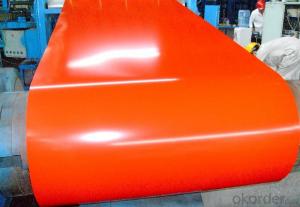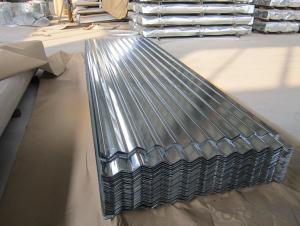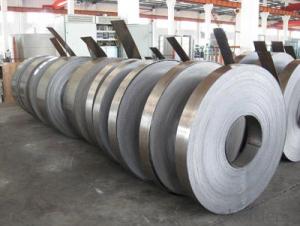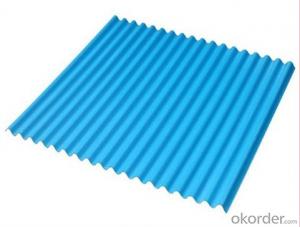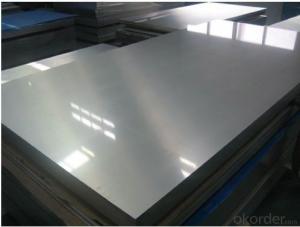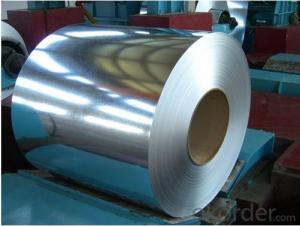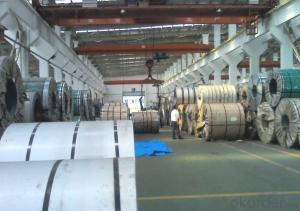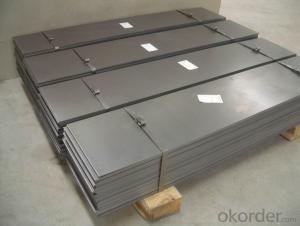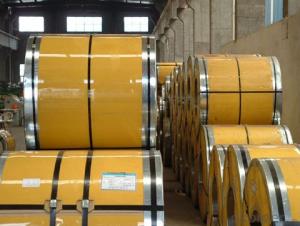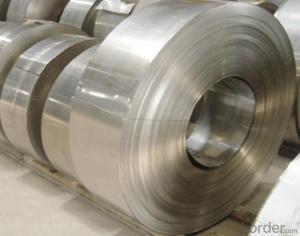Pre-painted Galvanized/Aluzinc Steel Sheet Coil with Prime Quality and Lowest Price Color is Orange
- Loading Port:
- Shanghai
- Payment Terms:
- TT OR LC
- Min Order Qty:
- 100 m.t.
- Supply Capability:
- 10000 m.t./month
OKorder Service Pledge
OKorder Financial Service
You Might Also Like
1.Structure of Pre-painted Galvanized/Aluzinc Steel Coil Description
With GI (aluzinc) as base metal, after pretreatment (degrease and chemical treatment) and liquid dope with several layers of color, then after firing and cooling, finally the plate steel is called pre-painted galvanized (aluzinc) steel. Pre-painted galvanized steel is good capable of decoration, molding, corrosion resistance. It generally displays workability, durability and weather resistance.
2.Main Features of the Pre-painted Galvanized/Aluzinc Steel Coil
• Excellent corrosion resistance
• Excellent weather resistance
• Capability of decoration, molding, corrosion resistance
• Workability, durability
• Excellent heat resistance performance
• High strength
• Good formability
• Good visual effect
3.Pre-painted Galvanized/Aluzinc Steel Coil Images
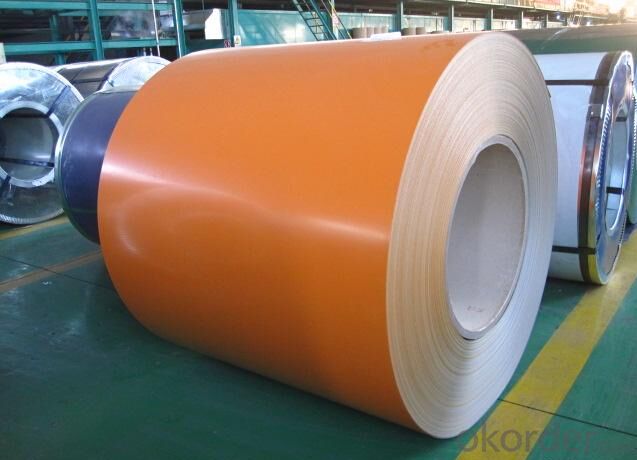
4.Pre-painted Galvanized/Aluzinc Steel Coil Specification
Quality standar: JIS G3312 CGCC & CGLCC
Hardness of P: Both soft and hard quality are available
Surface finish: with or without protect film
Thickness : 0.14-1.20 mm
Width : 914mm, 1000mm, 1220mm and 1250mm, thickness 600-1250mm is available
Finish by coil or sheet: Both sheet and coil are available
8Zinc coating: 60-275G/M2, both sides
Paint thickness for top side : 5 micron primer + (10-20) microns modified polyester, blue color code.
Paint thickness for back side: (5-10) microns Epoxy
Weight per coil: 4-6 tons, also can be upon customer's requirements
Max loading weight in one 20ft container : 25 tons generally
5. FAQ of Pre-painted Galvanized/Aluzinc Steel Coil
We have organized several common questions for our clients,may help you sincerely:
1. What is the minimum order quantity ?
Our MOQ is 50mt for each size. And we will consider to give more discount if you make big order like 1000 tons and more. Further more, the more appropriate payment term your offer the better price we can provide.
2. How long can we receive the product after purchase?
Usually within thirty working days after receiving buyer’s advance payment or LC. We will arrange the factory manufacturing as soon as possible. The cargo readiness usually takes 15-25 days, but the shipment will depend on the vessel situation.
3. How to guarantee the quality of the products?
We have established the international advanced quality management system,every link from raw material to final product we have strict quality test;We resolutely put an end to unqualified products flowing into the market. At the same time, we will provide necessary follow-up service assurance.
- Q:How are steel strips processed for fastening?
- Steel strips are processed for fastening through various methods such as cutting, shaping, and joining. These processes involve techniques like shearing, stamping, bending, and welding to create the desired shape and form of the steel strips. Additionally, surface treatments such as galvanization or coating may also be applied to enhance their durability and resistance to corrosion. Overall, the processing of steel strips for fastening involves a combination of mechanical and chemical processes to ensure their optimal performance in various applications.
- Q:Can steel strips be used for making wire or cable?
- Yes, steel strips can be used for making wire or cable. Steel strips are often used as the raw material for manufacturing various types of wire and cable products due to their strength, durability, and conductivity properties.
- Q:What are the standard dimensions for steel strips?
- The standard dimensions for steel strips can vary depending on their specific application and industry standards. However, common standard dimensions for steel strips typically range from 0.20mm to 6.0mm in thickness and 10mm to 1500mm in width.
- Q:Can steel strips be used in the production of watch straps?
- Watch straps can indeed be made using steel strips. The reason behind the popularity of steel strips as a material for watch straps lies in their durability, strength, and resistance to corrosion. These strips can be molded and adjusted to suit various watch designs and wrist sizes. Moreover, steel strips can be polished or coated with different finishes to elevate their look and make them visually attractive. All in all, steel strips offer a dependable and fashionable alternative for watch straps.
- Q:Are steel strips prone to warping or distortion?
- Yes, steel strips are prone to warping or distortion under certain conditions.
- Q:How are steel strips coated for protection?
- Steel strips are coated for protection through a process called galvanization. Galvanization involves applying a layer of zinc to the surface of the steel strips. This is done by either hot-dip galvanizing or electroplating. In hot-dip galvanizing, the steel strips are immersed in a bath of molten zinc at a temperature of around 450°C (842°F). The zinc reacts with the steel, forming a protective layer of zinc-iron alloy on the surface. This layer provides excellent corrosion resistance and protects the steel from rusting. Electroplating, on the other hand, involves immersing the steel strips in an electrolyte solution containing zinc ions. A direct electric current is then passed through the solution, causing the zinc ions to bond with the steel surface. This creates a thin but durable layer of zinc coating that safeguards the steel from corrosion. Both hot-dip galvanizing and electroplating provide effective protection for steel strips. The zinc coating acts as a barrier, preventing moisture and corrosive elements from reaching the steel surface. Additionally, even if the coating gets scratched or damaged, the sacrificial properties of zinc ensure that it corrodes first, protecting the underlying steel. Overall, steel strips are coated for protection using galvanization techniques, which involve the application of a zinc layer. This process significantly enhances the durability and longevity of the steel, making it more resistant to corrosion and extending its lifespan.
- Q:How are steel strips used in the renewable energy supply chain?
- Steel strips are used in the renewable energy supply chain for various applications, such as manufacturing wind turbines, solar panels, and energy storage systems. These strips are utilized in the construction of turbine towers, solar panel frames, and supports for energy storage infrastructure. The strength, durability, and versatility of steel make it an ideal material for these renewable energy technologies, ensuring reliable and long-lasting operation in the sustainable energy sector.
- Q:What are the common applications of hot-rolled steel strips?
- Hot-rolled steel strips are commonly used in various industries such as construction, automotive, and manufacturing. They are primarily used for making structural components, including beams, columns, and supports in buildings and bridges. Additionally, hot-rolled steel strips are utilized in the production of pipes, tubes, and railway tracks due to their high strength and durability. In the automotive sector, they are employed for manufacturing frames, chassis, and other structural parts. The versatility and cost-effectiveness of hot-rolled steel strips make them a popular choice in many applications where strength and reliability are crucial.
- Q:What are the different lengths available for steel strips?
- Steel strips are available in a variety of lengths to suit different applications and requirements. The lengths of steel strips can range from a few inches to several feet, depending on the intended use and the industry. Common lengths for steel strips can be found in standard sizes such as 12 inches, 24 inches, 36 inches, and so on. However, custom lengths can also be obtained by cutting longer strips to the desired size. Additionally, steel strips can be supplied in rolls or coils, which can have varying lengths depending on the thickness and width of the strip. Ultimately, the length of steel strips is determined by factors such as the specific industry, the intended use, and the customer's specifications.
- Q:How are steel strips supplied to customers?
- Customers typically receive steel strips through various methods, with one common approach being through steel service centers or distributors. These centers or distributors obtain steel strips in large quantities directly from steel mills or manufacturers, and then process and distribute them to customers based on their specific needs. The steel strips are generally supplied in tightly wound coils, which can vary in size and weight depending on customer requirements. These coils are stored in warehouses or storage facilities until customers place orders. When a customer submits an order, the steel service center or distributor retrieves the necessary coil from their inventory. The steel strips can be supplied in different forms, depending on the customer's preferences and logistical needs. They can be cut to specific lengths, slit into narrower strips, or leveled and flattened to ensure uniformity and precision. The steel strips are then securely packaged to protect them during transportation. Depending on the size and weight of the coils, they may be shipped by truck, rail, or even by sea for international customers. The coils are typically stacked and secured on pallets or loaded directly onto flatbed trucks or shipping containers. In addition to steel service centers, some manufacturers may also directly supply steel strips to their customers. This is more common for large-scale projects or when customers have specific requirements that can be better met by working directly with the manufacturer. Overall, the supply of steel strips to customers involves a well-coordinated process involving steel mills, service centers or distributors, and transportation logistics to ensure the timely and efficient delivery of the steel strips to customers.
1. Manufacturer Overview |
|
|---|---|
| Location | |
| Year Established | |
| Annual Output Value | |
| Main Markets | |
| Company Certifications | |
2. Manufacturer Certificates |
|
|---|---|
| a) Certification Name | |
| Range | |
| Reference | |
| Validity Period | |
3. Manufacturer Capability |
|
|---|---|
| a)Trade Capacity | |
| Nearest Port | |
| Export Percentage | |
| No.of Employees in Trade Department | |
| Language Spoken: | |
| b)Factory Information | |
| Factory Size: | |
| No. of Production Lines | |
| Contract Manufacturing | |
| Product Price Range | |
Send your message to us
Pre-painted Galvanized/Aluzinc Steel Sheet Coil with Prime Quality and Lowest Price Color is Orange
- Loading Port:
- Shanghai
- Payment Terms:
- TT OR LC
- Min Order Qty:
- 100 m.t.
- Supply Capability:
- 10000 m.t./month
OKorder Service Pledge
OKorder Financial Service
Similar products
New products
Hot products
Hot Searches
Related keywords
